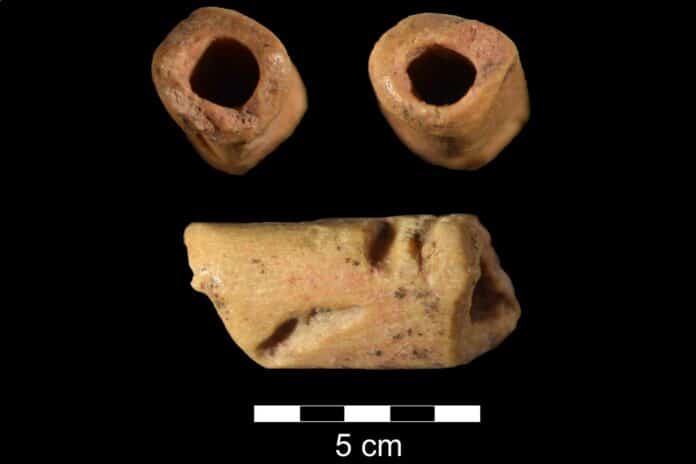The production and use of personal ornaments, most commonly beads, are essential indicators of increasing human cultural and social complexity in the Paleolithic, first in the Middle Stone Age of Africa and later in the Early Upper Paleolithic of Eurasia.
Although beads are not as well documented from early archaeo-logical contexts in the Americas, several examples have been reported from Paleoindian localities indicating that the first migrants to the Western Hemisphere made and used personal ornamentation, whether to decorate their bodies and clothing.
Relatively few beads have been recovered from secure Early Paleoindian contexts. University of Wyoming archaeology Professor Todd Surovell and his team and collaborators have made an exciting discovery at the La Prele Mammoth site in Converse County. They found a tube-shaped bead made of bone that dates back about 12,940 years. It is the oldest known bead in the Americas.
The bead discovered at the La Prele Mammoth site measures about 7 millimeters in length, with an average internal diameter of 1.6 millimeters. Initially, the research team considered the possibility that the bead might have been formed through carnivore consumption and digestion, but this was unlikely as carnivores were rare at the site. Moreover, the artifact was close to a dense collection of other cultural items, suggesting human involvement.
Furthermore, the grooves outside the bead indicate human craftsmanship, possibly made using stones or teeth. Ancient peoples probably used beads like this to adorn their bodies or clothing, providing valuable insights into their cultural practices and way of life.
The La Prele Mammoth site holds the remains of a young Columbian mammoth, along with an ancient camp used while butchering the animal. To determine the origin of the bone bead, scientists used a method called ZooMS, which examines collagen extracted from the bone.
Their analysis revealed that the bead was made from either a metapodial or a proximal phalanx bone of a hare, marking the first solid evidence of hare use during the Clovis period, which dates back around 12,000 years. This period is named after the Clovis archaeological site in New Mexico, known for distinctive stone tools found there.
Scientists noted, “We conclude that the bead was made from a metapodial or proximal phalanx of a hare (Lepus sp.). This find represents the first secure evidence for using hares during the Clovis period. While the use of hare bone to manufacture beads was a common practice in western North America during the Holocene, its origins can now be traced back to at least the terminal Pleistocene.”
Journal Reference:
- Todd A. Surovell, McKenna L. Litynski, Sarah A. Allaun, Michael Buckley, Todd A. Schoborg, Jack A. Govaerts, Matthew J. O’Brien, Spencer R. Pelton, Paul H. Sanders, Madeline E. Mackie, Robert L. Kelly. Use of hare bone for the manufacture of a Clovis bead. Scientific Reports, 2024; 14 (1) DOI: 10.1038/s41598-024-53390-9
